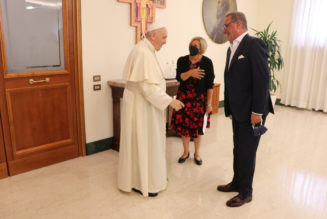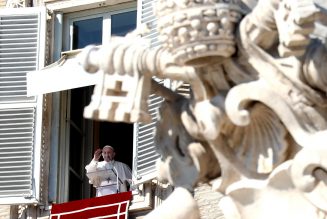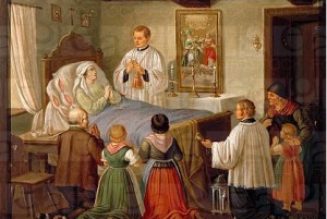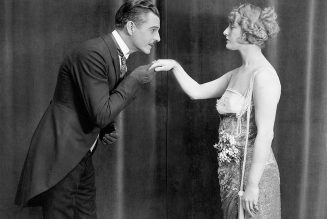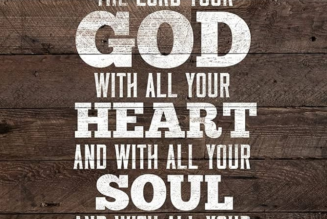
As noted last week, the Gospels of the Third, Fourth and Fifth Sundays of Lent can vary, but priests can always use the “scrutiny readings” — which also happen to be the readings prescribed for this year in the Lectionary — that are intended to prepare catechumens for Baptism at Easter.
Last week’s focused on the “living water” of grace Jesus promised the Samaritan Woman. This week focuses on Jesus as “the light of the world” who enlightens everyone who comes to him. This is one reason why, in Baptism, a child is presented with a lighted candle to “keep the flame of faith alive in his heart” until that day when — like the Wise Virgins — he “go[es] out to meet him with all the saints in the heavenly Kingdom.”
In today’s Gospel, Jesus “saw a man blind from birth. His disciples asked him, ‘Rabbi, who sinned, this man or his parents, that he was born blind?’”
The disciples’ question is motivated by the fact that they are good Jews and the state at that time of Judaism’s understanding of an afterlife.
It was only in Jesus’ day that Israel began to develop a clearer understanding of the afterlife, differentiated between the reward of eternal life with God and the loss of separation from him.
Re-read the second part of that last sentence. It was only in Jesus’ day that Israel came to understand life after death in a morally significant way.
Israel had always understood God’s relationship with human beings as having a moral component. The great contribution of Judaism (and Christianity) — which differentiated them from all the other “religions” of antiquity — was that the relationship between God and man stands on moral foundations. God is good and man is called to respond in goodness. Compare that, for example, with the mythologies of ancient Greece and Rome, where the gods were bigger but in no sense better (and often worse) than men.
So, if God’s relationship with people is based on morality, then God must deal justly with man. It’s clear: some people do good, some people evil.
But ancient Israel’s early understanding of the afterlife was that everyone ends in Sheol, a kind of unclear and in no sense desirable existence. So if everyone — good and evil — finds themselves in the same state, Sheol, then good and evil need to be punished somewhere, and the only place left is this life. That’s why the disciples ask: “Who sinned? Who did the evil that this man has been punished with blindness?”
Jesus, however, rejects this dichotomy. Of course, by the time of Christ a fuller understanding of the afterlife was emerging in Judaism. Jesus makes clear that the event John is about to recount is not about “who sinned” but “it is that the works of God might be made visible through him.” The encounter with the blind man will show us who Jesus is.
This man has been born blind. In that sense, he is everyman — every one of us — born blind because of original sin. Note that it is Jesus who reaches out to him; in this encounter, it is not the blind man who takes the initiative but Jesus. That is, of course, what is true about all sacraments: it is always God who takes the initiative in our lives.
Jesus “spat on the ground and made clay with his saliva and smeared the clay on his eyes.” Why? Jesus is clearly reaching back to Genesis: just as God made man from the clay of the ground, so he reminds the blind man of his human creation by God’s hand, by the power of God’s Word.
But that clay isn’t enough. Aware of the blind man’s wounded nature, Jesus sends him to “wash in the pool of Siloam.” His human nature is not enough. He needs the water — the water of Baptism — truly to “open his eyes.” And when the man does that, in obedience to God’s Word, he “came back able to see.”
Obedient to God’s Word, he “came back able to see.” Disobedient to God’s Word, the Pharisees will not see. They will deliberately close their eyes, willfully blinding themselves to God’s work because God does not fit their expectations.
These insights are not mine. St. Irenaeus of Lyons spoke of them in the second century A.D.
We can see how today’s Gospel is clearly relevant to Catholics preparing for Baptism at the Easter Vigil … and for Catholics to renew their baptismal vows at Easter.
Today’s Gospel is depicted by an illustration from the Codex Egberti, a Book of the Gospels made for Egbert, the Bishop of Trier in Germany. Egbert was bishop from 980-993, and the illustration dates from around 980.
One must pay attention to details of depictions of Jesus’ healings, especially of the blind, because he healed a number of blind persons, e.g., the blind Bartimaeus. Jesus’ healings of the blind are not generic (because people are unique), so one wants to identify which biblical episode a particular painting depicts.
This late 10th-century illumination clearly relates to today’s Gospel.
On the left of the painting are two Apostles (conveniently marked in abbreviation “Apostoli” over their heads). Remember that, for the Jews of Jesus’ day, any testimony had to stand on the concurrence of two or three witnesses (Deuteronomy 19:15). Jesus, who had called himself “the Light of the World” in the previous chapter of John not read today (8:12-18) invokes his own testimony and that of his Father (who has enabled his miracles) as establishing his veracity. Instead, in today’s Gospel we have the Pharisees trying to make a case against Jesus, without witnesses, discounting anything that challenged their refusal to see what had happened before their eyes.
Jesus is in the middle of the painting (“IHC XPC” — Jesus Christus). He has just smeared the eyes of the blind man (“Caecus”) with mud and saliva and directs him to wash in the pool of Siloam. The peacock pouring water into the tower is “Aqueductus” (the aqueduct), the pool “Syloae” (Siloam).
Jesus’ and the Apostles’ eyes are wide open; the blind man’s shut. The peacock, which has spots in its tail that look like eyes, is a symbol in Christian iconography for the all-seeing God, the drinking peacock alludes to the waters of eternal life (tying in with last week’s Gospel). He pours forth those illumining waters into Siloam, where the blind man’s eyes will be open.
This depiction is spare, typical for religious art of the era. It shows the essential elements as one act, without regard to chronology. It’s all there: Jesus, the Apostles, the pool, the water. Nothing else is needed. And it is all made possible by Christ’s Paschal Mystery: Jesus’ halo already contains a cross, even though these events precede his Passion, Death and Resurrection. For God, however, all time is now.

![A Snapshot of Catholicism in China Under Xi Jinping [login required, but it’s free and the article is excellent]…](https://salvationprosperity.net/wp-content/uploads/2024/06/a-snapshot-of-catholicism-in-china-under-xi-jinping-login-required-but-its-free-and-the-article-is-excellent-327x219.jpg)
